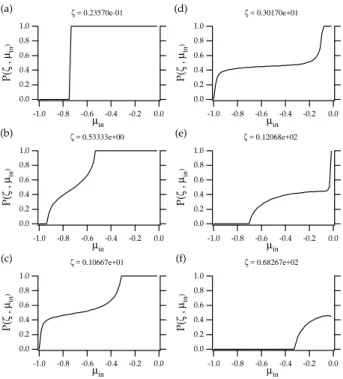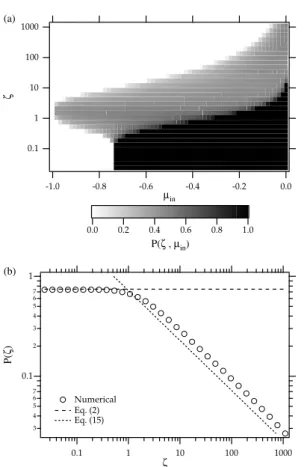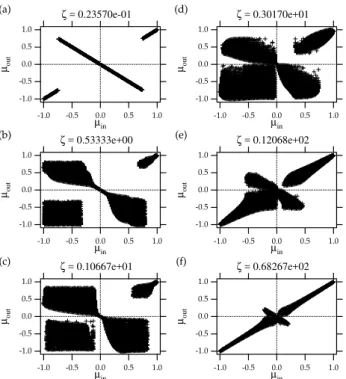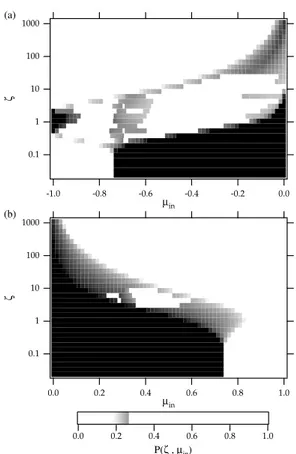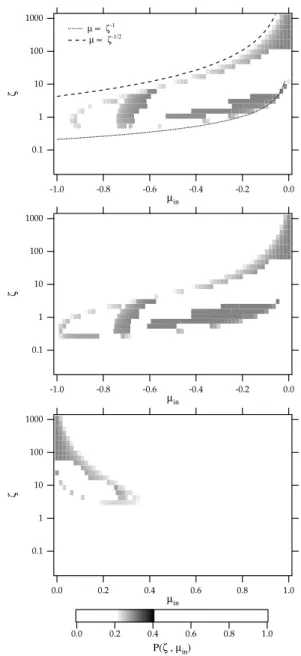www.nonlin-processes-geophys.net/15/265/2008/ © Author(s) 2008. This work is licensed
under a Creative Commons License.
in Geophysics
Nonadiabatic interaction between a charged particle and an MHD
pulse
Y. Kuramitsu1and T. Hada2
1Institute of Laser Engineering, Osaka University, Suita, Japan
2ESST, Interdisciplinary Graduate School of Engineering Sciences, Kyushu University, Kasuga, Japan
Received: 4 December 2007 – Revised: 13 February 2008 – Accepted: 13 February 2008 – Published: 17 March 2008
Abstract. Interaction between a magnetohydrody-namic (MHD) pulse and a charged particle is discussed both numerically and theoretically. Charged particles can be accelerated efficiently in the presence of spatially corre-lated MHD waves, such as short large amplitude magnetic structures, by successive mirror reflection (Fermi process). In order to understand this process, we study the reflection probability of particles by the MHD pulses, focusing on the adiabaticity on the particle motion. When the particle velocity is small (adiabatic regime), the probability that the particle is reflected by the MHD pulse is essentially determined only by the pitch angle, independent from the velocity. On the other hand, in the non-adiabatic regime, the reflection probability is inversely proportional to the square root of the normalized velocity. We discuss our numerical as well as analytical results of the interaction process with various pulse amplitude, pulse shape, and the pulse winding number. The reflection probability is universally represented as a power law function independent from above pulse properties.
1 Introduction
Since the space plasma is collisionless, various kinds of transport and dissipations take place via wave-particle in-teractions. In the acceleration of energetic particles or cosmic rays, magnetohydrodynamic (MHD) waves, which are basic low frequency waves in plasmas, play an essen-tial role. Diffusion in the velocity space (energy diffu-sion), transport in the real space, and the pitch angle dif-fusion of the particles by the MHD waves have been dis-cussed extensively, however, most of the arguments are based on the quasi-linear theory (QL) (e.g., Kennel and Engel-mann, 1966; Lee, 1971; Lyons, 1974; Gary and Feldman, 1978; Lee, 1982; Schlickeiser, 1989). There are two
as-Correspondence to:Y. Kuramitsu
(kuramitsu-y@ile.osaka-u.ac.jp)
sumptions in the quasi-linear theory; the amplitude of the wave is small, and the random phase approximation (R.P.A), i.e., there is no correlation between wave modes. How-ever, the MHD waves observed in space often have large amplitude, therefore, it is expected to have phase correla-tion via nonlinear interaccorrela-tion between wave modes (Nariyuki and Hada, 2005, 2006). In fact, large amplitude MHD waves with pulse like structures are abundant in space plas-mas; for instance, short large amplitude magnetic structures (SLAMS) (Schwartz and Burgess, 1991; Schwartz et al., 1992; Giacalone et al., 1993; Mann et al., 1994) and shock-lets (Hoppe et al., 1981; Tsurutani et al., 1990, 1997). These waveforms are considered as an evidence for strong spatial phase correlation of wave modes (Koga and Hada, 2003; Hada et al., 2003). For acceleration and thermalization of charged particles by these waves, the assumptions of the quasi-linear theory are not appropriate.
Gaussian pulse winding number n = lk =2
b
l
Fig. 1. A typical Gaussian pulse used in the run. The solid, broken,
and dotted lines represent theBy, Bz, and the envelope of wave
packet.
the acceleration and scattering mechanism due to the MHD pulses, we discuss the mirror reflection of a particle by one wave packet, paying special attention to adiabatic and non-adibatic motion of charged particles.
In this paper we discuss nonlinear interaction between a charged particle and a wave packet numerically and theo-retically. In Sect. 2 we describe our model and formula-tions. We numerically solve the particle trajectories, firstly, when the winding number equals zero, and then when it is finite. We calculate phase integrated and phase-pitch angle integrated reflection probabilities. In Sect. 3 we analyze the particle motion and formulate the reflection probability func-tions. We give conclusions in Sect. 4.
2 Numerical experiment 2.1 Model and basic equations
Quite often the mirror reflection of a particle is simply ex-plained by the adiabatic invariant of a magnetic moment mv2
⊥/(2B), wheremis the mass of the particle,v⊥is the per-pendicular component of the particle velocity to the magnetic field, andBis the strength of the magnetic field. Introducing the pitch angle of particle,v⊥≡Vsinα, with adiabatic inter-actionV∼const., one can write the invariance of the moment as
sin2α
B =
1 Bm
, (1)
whereBm is the magnetic field where the particle is
re-flected (α→π/2). Giving a wave packet with its maximum magnetic field strengthBmax, we define a critical pitch angle
αc by sin2αc=B0/Bmax, whereB0is the background
mag-netic field. Particles with pitch angle less (larger) than αc
are transmitted to (reflected by) the wave packet. There is no energy dependence in this argument. If the particle
distri-bution is isotropic, the reflection probability is given by the integration of Eq. (1) as,
Pad =
1− B0 Bmax
1/2
. (2)
In reality, the interaction between a particle and a wave packet is not necessary to be adiabatic. For instance, SLAMS are considered to form a transition of the quasi-parallel shocks (Schwartz and Burgess, 1991), where energetic par-ticles are often detected (Giacalone et al., 1993). A typi-cal spatial stypi-cale of SLAMS is∼3×106m, which is compa-rable to the gyroradius (4×106m) of the energetic particles with∼20 keV when the magnetic field magnitude is∼5 nT (Schwartz et al., 1992; Giacalone et al., 1993). Furthermore, the typical gradients of magnetic field changes within the SLAMS can be∼105m, much shorter than the SLAMS scale (Lucek et al., 2004). As far as energetic particles or cosmic rays are concerned, the adiabatic assumption is not appropri-ate. We consider neither an electrostatic potential of the wave packet, nor the temporal and spatial change of the wave phase or group velocity since the scale of the background change is much larger than that of pule-particle interactions. Note that when the group velocity of the wave packet is different from the phase velocity of local MHD waves (e.g., Schwartz et al., 1992) and/or when the electrostatic potential is con-cerned, there is a possibility of efficient particle accelera-tion by gyroresonant surfing (Kuramitsu and Krasnoselskikh, 2005a,b,c). It will be investigated elsewhere.
We numerically calculate a trajectory of a particle using a simple wave packet and discuss how a particle is reflected by the wave packet. We consider the interaction in a coordinate moving with the wave packet, where there is no wave electric field. Therefore, the particle energy is conserved. We solve an equation of motion of a particle,
mdv dt =
e
cv×B. (3)
The D.C. magnetic field is in thex direction and a Gaus-sian wave packet is given by (Fig. 1),
δB=By(x)+iBz(x)=Aexp
−x L
2
+ikx+iθ
(4) HereAandLare the amplitude and width of wave packet, and k and θ are the wave number and phase constant of the carrier wave, respectively. Using the advantage of the constant particle energy, we normalize all the quantities us-ing the magnitude of particle velocity V, the background magnetic field B0, and the gyrofrequency ≡eB0/mc.
We also define the normalized wave amplitude b=A/B0,
-1.0 -0.5 0.0 0.5 1.0 µout
-1.0 -0.8 -0.6 -0.4 -0.2 0.0
µin
ζ = 0.23570e-01
-1.0 -0.5 0.0 0.5 1.0 µout
-1.0 -0.8 -0.6 -0.4 -0.2 0.0
µin
ζ = 0.68267e-02
-1.0 -0.5 0.0 0.5 1.0 µout
-1.0 -0.8 -0.6 -0.4 -0.2 0.0
µin
ζ = 0.12068e+02
-1.0 -0.5 0.0 0.5 1.0 µout
-1.0 -0.8 -0.6 -0.4 -0.2 0.0
µin
ζ = 0.30170e+01
-1.0 -0.5 0.0 0.5 1.0 µout
-1.0 -0.8 -0.6 -0.4 -0.2 0.0
µin
ζ = 0.10667e+01
-1.0 -0.5 0.0 0.5 1.0 µout
-1.0 -0.8 -0.6 -0.4 -0.2 0.0
µin
ζ = 0.53333e+00 (a) (b) (c) (d) (e) (f)
Fig. 2. Comparison between the particle pitch angle cosines before
and after the interaction with the Gaussian pulse withb=2 andn=0.
Each plot corresponds to different values of the normalized particle
velocity,V /L=ζ.
ψ=arctanBy/Bz−arctanvy/vz, and the pitch angle cosine
of the particleµ=cosα. The normalized wave packet width l(also the inverse value of itζ) has significant physical mean-ing. This is a ratio between the time necessary for a particle to traverse the wave packet and the Larmor period, or the ra-tio of Larmor radius to the scale of the width of wave packet. Whenlis large, i.e., the wave packet width is large or equiv-alently the particle velocity is small. In this case the particle feels the change of the field slowly. In contrast, whenl is small, the particle feels a rapid change of the field and the interaction becomes non-adiabatic.
2.2 Winding numbern=0
First let the “winding number”n≡Lk=0. The winding num-ber corresponds to the approximate numnum-ber of rotations that the transverse magnetic field makes within the wave packet. We fix the amplitude of wave packet (b=2) and change l. Thus the critical pitch angle cosineµc≡cosαc=0.743 from
Eq. (1). We inject particles with various pitch angles and gyrophases from a point sufficiently distant from the wave packet.
Figure 2 shows the comparison of pitch angle cosine be-fore and after the interaction. Different panels correspond to different values ofl. Linesµin= ±µoutcorrespond to
com-plete conservation of the first adiabatic invariant. Whenµ
1.0 0.8 0.6 0.4 0.2 0.0 P( ζ , µin )
-1.0 -0.8 -0.6 -0.4 -0.2 0.0
µin ζ = 0.68267e+02 1.0 0.8 0.6 0.4 0.2 0.0 P( ζ , µin )
-1.0 -0.8 -0.6 -0.4 -0.2 0.0
µin ζ = 0.12068e+02 1.0 0.8 0.6 0.4 0.2 0.0 P( ζ , µin )
-1.0 -0.8 -0.6 -0.4 -0.2 0.0
µin ζ = 0.30170e+01
1.0 0.8 0.6 0.4 0.2 0.0 P( ζ , µin )
-1.0 -0.8 -0.6 -0.4 -0.2 0.0
µin ζ = 0.10667e+01 1.0 0.8 0.6 0.4 0.2 0.0 P( ζ , µin )
-1.0 -0.8 -0.6 -0.4 -0.2 0.0
µin ζ = 0.53333e+00 1.0 0.8 0.6 0.4 0.2 0.0 P( ζ , µin )
-1.0 -0.8 -0.6 -0.4 -0.2 0.0
µin ζ = 0.23570e-01 (a) (b) (c) (d) (e) (f)
Fig. 3. Phase integrated reflection probability, P (ζ, µin),
calcu-lated from Fig. 2 is shown.
change its sign, the particle is reflected by the wave packet. On the other hand, whenµkeep its sign same, the particle goes through the wave packet. When the winding number n=0 (linear polarization), it is not affected by whether the particles are injected from either side of the packet because of the symmetry. We release particles from the positivexside of the packet, thus the particles withµout>0 (µout<0)
corre-spond to reflected (transmitted) particles. Whenl is large (i.e., smallζ≡l−1), the interaction is well explained by the adiabatic theory (a). The particles withµ<µc(in loss cone)
are transmitted to the wave packet, otherwise reflected, inde-pendent ofψ. Whenlis slightly less, the breakdown of the adiabatic invariant is apparent; some particles in loss cone are reflected depending onψ, and some particles outside the loss cone are transmitted (b). Whenlis even less, it is diffi-cult to find a trace of adiabatic interaction (c–e). With further reducingl, particles are scarcely reflected (e–f).
Figure 3 shows the phase-averaged reflection probability against µ, obtained by phase integration of the results of Fig. 2. The panel (a) represents the adiabatic case; the re-flection probability is 0 within the loss cone and 1 outside. Asζ increases, the probability becomes finite inside the loss cone (b). As ζ increases, the boundary between the trans-mittion and reflection becomes obscure (c–d). With further increasingζ,P continues to decrease and vanishes eventu-ally.
0.1 1 10 100 1000
ζ
-1.0 -0.8 -0.6 -0.4 -0.2 0.0
µin
1.0 0.8 0.6 0.4 0.2 0.0
P(ζ , µin)
3 4 5 6 7
0.1
2 3 4 5 6 7
1
P(
ζ
)
0.1 1 10 100 1000
ζ
Numerical Eq. (2) Eq. (15)
(a)
(b)
Fig. 4. In(a)image plot of the reflection probabilityP (ζ, µin)is
shown with the same pulse parameters as in Fig. 2. In(b)
pitch-angle integrated reflection probabilityP (ζ )is shown. Values
ob-tained from the numerical calculations are superposed in the plot as circles. Dashed and dotted lines denote the adiabatic theory Eq. (2), and the non-adiabatic asymptote Eq. (15), respectively.
horizontal axis isµin. It is clear that, whenζ is small, the
in-teraction is adiabatic, while the non-zero values of reflection probability is particular enhanced aroundζ∼1. Whenζ≫1, P decreases as|µin|increases.
Further integration ofP (ζ, µin)in Fig. 4a overµinyields
the reflection probability based on the isotopic distribution, P (ζ )in Fig. 4b. HereP (ζ )is plotted versusζ in logarith-mic scales. Ifζ is small, the reflection probability is well explained by the adiabatic theory (Eq. 2). Non-adiabaticity appears aroundζ∼1. Asζ increases, the reflection probabil-ity decreases asζ−1/2.
We show another example with n=0. Figure 5a shows the reflection probability P (ζ, µin) with the wave packet
amplitudeb=6, and Fig. 5b shows its integration overµin.
Note that the reflection probability is enhanced atζ∼1 with µin∼ −1 (beam particles) in (a). This enhancement was not
found whenb=2, although Fig. 5b shows similar character-istics to the case withb=2; the curve consists of an adiabatic part and non-adiabatic power law decrease. The index of power law is again−1/2.
5 6 7 8 9
0.1
2 3 4 5 6 7 8 9
1
P(
ζ
)
0.1 1 10 100 1000
ζ
Numerical Eq. (2) Eq. (15) 0.1
1 10 100 1000
ζ
-1.0 -0.8 -0.6 -0.4 -0.2 0.0
µin
1.0 0.8 0.6 0.4 0.2 0.0
P(ζ , µin) (a)
(b)
Fig. 5. Same as Fig. 4 except that the pulse amplitude isb=6.
2.3 Winding numbern6=0
Here we discuss non-zero winding number (we chosen=2 with amplitudeb=2) . In this case the particles with vk<0 can resonate with the wave, while the particles with vk>0 cannot. Note that we consider particles with positive charge here, however, the resonance condition also depends on the sign of the particle charge. When negative charged particles are concerned, one has to simply change the sign of the res-onance condition. Figures 6 and 9 show the results plotted in the same formats as Figs. 2 and 4b. The only difference in the parameter isn=2. In Fig. 6a, the interaction between the wave packet and the particle can be well explained by the adiabatic theory. The interaction does not depend on from which side the particle collides the wave packet. Asζ in-creases (b–e), the scattering shows some deviation from the adiabatic line as already shown in Fig. 2, and moreover the right and left symmetry is broken. In particular, the deviation from the adiabatic line (µin=±µout) is larger for the particles
with resonant sense (µin<0) than the others. The scattering
of particles becomes symmetric with respect to µin in the
regimeζ≫1 (e–f).
-1.0 -0.5 0.0 0.5 1.0 µout
-1.0 -0.5 0.0 0.5 1.0
µin
ζ = 0.23570e-01
1.0 0.5 0.0 -0.5 -1.0 µout
-1.0 -0.5 0.0 0.5 1.0
µin ζ = 0.68267e+02
-1.0 -0.5 0.0 0.5 1.0 µout
-1.0 -0.5 0.0 0.5 1.0
µin
ζ = 0.12068e+02
-1.0 -0.5 0.0 0.5 1.0 µout
-1.0 -0.5 0.0 0.5 1.0
µin
ζ = 0.30170e+01
-1.0 -0.5 0.0 0.5 1.0 µout
-1.0 -0.5 0.0 0.5 1.0
µin ζ = 0.10667e+01
-1.0 -0.5 0.0 0.5 1.0 µout
-1.0 -0.5 0.0 0.5 1.0
µin
ζ = 0.53333e+00 (a) (b) (c) (d) (e) (f)
Fig. 6. Same as Fig. 2 except that the pulse winding number isn=2.
Initial particle pitch angle cosine ranges fromµ= −1 toµ=1, i.e.,
the plots represent particles injected from either side of the pulse.
This is more clearly represented in Fig. 8. The enhance-ment of the probability, as seen whenn=0 andb=6 (Fig. 5a), appears only when the particles can resonate with the waves. On the other hand, as for the non-resonant particles, the en-hancement of probability is in the adiabatic domain.
The pitch angle integrated reflection probability (corre-sponding to Fig. 8) is shown in Fig. 9. The reflection prob-ability is close to the prediction of adiabatic theory when ζ is small, and it decreases with power law with large ζ asymptotically. Here the index of the power law is again −1/2. The numerical runs with other winding numbers and the wave amplitude show qualitatively similar results (not shown). Furthermore, similar results (not shown) are ob-tained when we use sech2 type wave packet. In all cases the pitch angle integrated probability has the common char-acteristics;P∼const.for smallζ andP∼ζ−1/2for largeζ.
3 Theoretical analysis
It is easy to physically understand that the interaction is adi-abatic whenζ is small; when the particle velocity is small or the wave packet width is large, the change of the field that a particle “sees” is small. Then how about the non-adiabatic regime?
Usingµ(=cosα, the pitch angle cosine of the particle) andψ (=arctanBy/Bz−arctanvy/vz, the difference between
1.0 0.8 0.6 0.4 0.2 0.0 P( ζ , µin )
-1.0 -0.5 0.0 0.5 1.0
µin ζ = 0.68267e+02
1.0 0.8 0.6 0.4 0.2 0.0 P( ζ , µin )
-1.0 -0.5 0.0 0.5 1.0
µin ζ = 0.12068e+02
1.0 0.8 0.6 0.4 0.2 0.0 P( ζ , µin )
-1.0 -0.5 0.0 0.5 1.0
µin ζ = 0.30170e+01
1.0 0.8 0.6 0.4 0.2 0.0 P( ζ , µin )
-1.0 -0.5 0.0 0.5 1.0
µin ζ = 0.10667e+01
1.0 0.8 0.6 0.4 0.2 0.0 P( ζ , µin )
-1.0 -0.5 0.0 0.5 1.0
µin ζ = 0.53333e+00
1.0 0.8 0.6 0.4 0.2 0.0 P( ζ , µin )
-1.0 -0.5 0.0 0.5 1.0
µin ζ = 0.23570e-01 (a) (b) (c) (d) (e) (f)
Fig. 7. Same as Fig. 3 except that the pulse winding number is
n=2.
particle gyrophase and a wave phase), we can rewrite Eq. (3) as follows (cf, Kuramitsu and Krasnoselskikh, 2005a,b),
dµ
dt =(1−µ
2)1/2b
wsinψ (5a)
dψ
dt =kµ+1− µ
(1−µ2)1/2bw(x)cosψ, (5b)
wherebw(x)gives the wave envelope,
bw(x)=be−(
x l)
2
. (6)
Equations (5a), (5b), and the following equation make a closed set of equations,
dx
dt =µ. (7)
Since the above equations is highly nonlinear, it is difficult to find an exact set of general solutions, therefore, we seek for an approximate solution by iteration.
The zeroth order trajectory without perturbation isµ=µ0,
ψ=(kµ0+1)t +ψ0, andx=x0+µ0t wherex0, µ0, and
ψ0 are constants determined by the initial conditions. Let
µ=µ0+δµ, and we integrate Eq. (5a) along the zeroth order
0.1 1 10 100 1000
ζ
1.0 0.8 0.6 0.4 0.2 0.0
µin
0.1 1 10 100 1000
ζ
-1.0 -0.8 -0.6 -0.4 -0.2 0.0
µin
1.0 0.8 0.6 0.4 0.2 0.0
P(ζ , µin) (a)
(b)
Fig. 8. Image plots of the reflection probability P (ζ, µin) are
shown whenb=2 andn=2. Panel(a)and (b)represent particles
with−1<µin<0 (i.e., the particles can be cyclotron resonant with
the carrier wave) and 0<µin<1 (i.e., the particles cannot be
cy-clotron resonant with the carrier wave).
δµ=
Z t2 t1
dt
b(1−µ20)1/2exp
−
x
0+µ0t
l
sin(kµ0t+t+ψ0).
(8)
Equation (8) is expressed using the error function (Aki-moto, 1997).
δµ=bl(1−µ
2 0)1/2
µ0
exp
"
−1 4
n+ l µ0
2#
× √
π
2 [erf(ξ(t2))−erf(ξ(t1))] sin8, ξ(t )=x0+µ0t
l −
i 2
n+ l µ0
,
(9)
where8=ψ0−kx0−x0/µ0is another constant determined
by the initial conditions. The first term of Eq. (9) has a factor of(1−µ20)1/2, representing that beam particles (µ=±1) are not influenced by the wave packet. Furthermore, the index part of Eq. (9) is more interesting; the zero point of the ar-gument of the exponential function corresponds to the linear cyclotron resonance condition, which is written as below in original variables in the plasma frame,
ω−kvx−=0. (10)
Therefore, the particles satisfying the linear resonance condition undergo strong scattering. This solution is correct within a short time scale, in which a particle begins to inter-act with the wave packet.
We consider whether a particle can be reflected after a long time. Although the deviation from the real trajectory grows, we can still discuss whether a particle will be reflected after a long time in the following way. By lettingt2= −t1=∞in Eq. (9), we have,
µout=µ0+√π bl
(1−µ20)1/2 µ0
exp
"
−1 4
n+ l µ0
2#
sin8. (11) A necessary condition for the particle to be reflected by the wave packet is µout<0(>0)forµ0>0(<0). The ratio that
µout changes the sign for particles with various gyrophase
(0<8<2π) with a certainµ0gives the reflection probability
P (ζ, µ0).
P (ζ, µ0)=
2R8c
−π/2d8
R2π
0 d8
=8πc +1 2,
(12)
where8cis the value of8atµout=0, which is written as
8c= −arcsin
(
µ20 √
π bl(1−µ20)1/2exp
"
1 4
n+ l µ0
2#)
.
(13) Since the maximum value of8cis 0, the reflection
proba-bilityP (ζ, µ0)in Eq. (12) is 1/2 at most.
This is plotted in the µ0−ζ phase space in Fig. 10. In
slightly smaller. During the adiabatic mirror reflection, the pitch angle changes the sign while conserving the energy. Therefore, it is necessary to include all the higher order terms in Eqs. (5a) and (5b). In our formulations the adiabatic mir-ror reflection is not treated. Whenn6=0, we can understand the qualitative behavior of the probability function such as the breakdown of the symmetry by the effect of the linear cyclotron resonance. When the resonance exists, the scatter-ing is strong in the region where the index of Eq. (9) is close to 0. When the resonance does not exist, the index will not become 0, thus the scattering is small. The reflection prob-ability Eq. (12), which is obtained theoretically, explains the dependence on the winding number.
We consider the power law type decay of the pitch angle integrated reflection probability in the non-adiabatic regime. When ζ≫1, only particles with pitch angle not close to 0 or π can be reflected by the wave packet (|µ0|≪1),
and the interaction time between the particle and the wave packet (L/µ0V) is much shorter than the Larmor period
(|µ0|/ l≫1). Then Eq. (11) can be rewritten asµout∼µ0+
√
π blµ−01e−n2/4sin8. When n=0, a necessary condition for the particle to be reflected by the wave packet is rewritten as follows.
µ20<−√π blsin8 (14)
Above argument is appropriate since the upper boundary on which the reflection probability becomes 0 is written as µ0∝ζ−1/2in Fig. 10a. On the other hand, the lower
bound-ary representing the adiabatic limit is expressed asµ0∝ζ−1.
The latter relation represents the ratio between gyroperiod and the interaction time between the particle and the wave packet. Whenµ0ζ=V µ0/L≪1, i.e., whenµ0≪1, even if
ζ >1, the interaction is still adiabatic. Forµ0<0, letting
in-tegration domain to−(√π bl)1/2<µ0<0 from Eq. (14)
(be-cause of−1<sin8<1), the pitch angle integrated reflection probability is written in the non-adiabatic limit as,
P (ζ )∼
R0
−(√π bl)1/2P (ζ, µ0)dµ0
R0
−1dµ0
∼
Z 0
−(√π bl)1/2
−1 π arcsin
µ20 √
π bl
!
+1 2
!
dµ0
=2π−3/4(bl)1/2Eπ 4,2
,
(15)
where E is the elliptic function of the second kind. One can get the same result forµ0>0. It is shown thatP (ζ )is
proportional toζ−1/2as the asymptotic behavior in the non-adiabatic limit. Whenn=0,P (ζ )∼0.50774×√bζ−1/2. This is shown in Fig. 4b and in Fig. 5b. The analytical estimations explain the numerical results well. Whenn6=0 we simply
3 4 5 6 7 0.1
2 3 4 5 6 7 1
P(
ζ
)
0.1 1 10 100 1000
ζ
Eq. (2) Resonance Non-resonance
Fig. 9. Same as Fig. 4b except that n=2. Circles and squares denote results from numerical simulation with initial particles rang-ing within 0<µin<1 and−1<µin<0, respectively. The dotted line corresponds to the value expected from the adiabatic theory, Eq. (2).
need to multiply the estimation above by e−n2/8. The re-flection probability from numerical experiments withn=10 (not shown) are smaller than the cases of n=0 and n=2. The above discussion is correct qualitatively, but not quan-titatively. The reason of the underestimation comes from the approximation on non-adiabaticity, which is not satisfied aroundµ0∼0.
4 Conclusions
We have discussed the interaction between a charged particle and an MHD wave packet numerically and theoretically.
When the scale of the particle is smaller than the wave packetζ (≡V /L)≪1, the reflection can be well explained by the adiabatic theory. The transition from reflection to transmission is well described by the critical pitch angle; the phase integrated probability function P (ζ, µin) is unity or
zero depending on whether the particles are outside or in-side of the loss cone. The pitch angle integrated reflection probability functionP (ζ )agrees with the prediction of adi-abtic theory Eq. (2) whenζ≪1. When the particle scale is comparable to the wave packet widthζ∼1, non-adiabaticity appears. The first adiabatic invariant does not conserve any more and the reflection probability can be non-zero in the loss cone. The probability function P (ζ )decreases as the particle scale increases and approaches a asymptotic line ζ−1/2.
We calculate the probability functionsP (ζ, µin)
analyti-cally and show that the cyclotron resonance between the par-ticle and the wave packet can explain non-adiabatic mirror reflection and the breakdown of symmetry regarding the in-jection pitch angle cosine,µin. The reason why the particles
0.1 1 10 100 1000
ζ
-1.0 -0.8 -0.6 -0.4 -0.2 0.0
µin
µ ∝ ζ-1 µ ∝ ζ-1/2
0.1 1 10 100 1000
ζ
1.0 0.8 0.6 0.4 0.2 0.0
µin
0.1 1 10 100 1000
ζ
-1.0 -0.8 -0.6 -0.4 -0.2 0.0
µin
1.0 0.8 0.6 0.4 0.2 0.0
P(ζ , µin)
Fig. 10. Contour plots of the analytically obtained reflection
prob-ability functionP (ζ, µin). The pulse amplitude isb=2, and the
pulse winding number isn=0(a),n=2 with resonant sense of
po-larity(b), andn=2 with non-resonant sense of polarity(c).
that those particles can resonant with the inner structure of wave packet. The reflection probabilityP (ζ, µin)estimated
by Eq. (12) explains the reflection probability obtained by the numerical experiment.
Integration of Eq. (12) overµ0gives the pitch angle
inte-grated reflection probability functionP (ζ ). The assimptotic value of this function tends to beζ−1/2. Note that the pitch angle used in this paper is in the wave packet frame, rather than, e.g., a plasma bulk frame.
The power law index−1/2 shows universality; the power law index is−1/2 independent of winding number, wave
am-plitude, and whether or not particles can resonant with waves. Even when we apply the other type of wave packets such as sech2, the reflection probability function decrease asζ−1/2. Acknowledgements. The authors would like to thank A. Kageyama, V. Krasnoselskikh and V. Lobzin for their helpful comments.
Edited by: R. Grimshaw
Reviewed by: D. H. Burgess and another anonymous referee
References
Akimoto, K.: Theory of pulse-particle interaction in one dimension, Phys. Plasmas, 4, 3101–3112, 1997.
Classen, H.-T. and Mann, G.: Motion of ions reflected off quasi-parallel shock waves in the presence of large-amplitude magnetic field fluctuations, Astron. Astrophys., 330, 381–388, 1998. Gary, S. P. and Feldman, W. C.: A second-order theory for k parallel
B sub 0 electromagnetic instabilities, Phys. Fluids, 21, 72–80, 1978.
Giacalone, J., Schwartz, S. J., and Burgess, D.: Observations of suprathermal ions in association with SLAMS, Geophys. Res. Lett., 20, 149–152, 1993.
Hada, T., Koga, D., and Yamamoto, E.: Phase coherence of MHD waves in the solar wind, Space Sci. Rev., 107, 463–466, doi: 10.1023/A:1025506124402, 2003.
Hoppe, M. M., Russell, C. T., Frank, L. A., Eastman, T. E., and Greenstadt, E. W.: Upstream hydromagnetic waves and their as-sociation with backstreaming ion populations-ISEE 1 and 2 ob-servations, J. Geophys. Res., 86, 4471–4492, 1981.
Kennel, C. F. and Engelmann, F.: Velocity space diffusion from weak plasma turbulence in a magnetic field, Phys. Fluids, 9, 2377, 1966.
Koga, D. and Hada, T.: Phase coherence of foreshock MHD waves: wavelet analysis, Space Sci. Rev., 107, 495–498, doi:10.1023/A: 1025510225311, 2003.
Kuramitsu, Y. and Hada, T.: Acceleration of charged particles by large amplitude MHD waves: effect of wave spatial correlation, Geophys. Res. Lett., 27, 5, 629–632,, 2000.
Kuramitsu, Y. and Krasnoselskikh, V.: Acceleration of charged par-ticles by gyroresonant surfing at quasi-parallel shocks, Astron. Astrophys., 438, 391, 2005a.
Kuramitsu, Y. and Krasnoselskikh, V.: Particle acceleration by el-liptically and linearly polarized waves in the vicinity of quasi-parallel shocks, J. Geophys. Res. (Space Physics), 110, A10108, doi:10.1029/2005JA011048, 2005b.
Kuramitsu, Y. and Krasnoselskikh, V.: Gyroresonant surfing accel-eration, Phys. Rev. Lett., 94, 31 102, 2005c.
Lee, M. A.: Self-consistent kinetic equations and the evolution of a relativistic plasma in an ambient magnetic field, Plasma Physics, 13, 1079–1098, 1971.
Lee, M. A.: Coupled hydromagnetic wave excitation and ion accel-eration upstream of the earth’s bow shock, J. Geophys. Res., 87, 5063–5080, 1982.
Lucek, E., Horbury, T., Balogh, A., Dandouras, I., and R`eme, H.: Cluster observations of structures at quasi-parallel bow shocks, Ann. Geophys., 22, 2309–2313, 2004,
Lyons, L. R.: General relations for resonant particle diffusion in pitch angle and energy, J. Plasma Phys., 12, 45, 1974.
Mann, G. and Classen, H.-T.: Electron acceleration to high ener-gies at quasi-parallel shock waves in the solar corona., Astron. Astrophys., 304, 576 pp., 1995.
Mann, G., Luehr, H., and Baumjohann, W.: Statistical analysis of short large-amplitude magnetic field structures in the vicinity of the quasi-parallel bow shock, J. Geophys. Res., 99, 13 315, 1994. Nariyuki, Y. and Hada, T.: Self-generation of phase coherence in
parallel Alfv´en turbulence, Earth Planets Space, 57, 2005. Nariyuki, Y. and Hada, T.: Remarks on nonlinear relation among
phases and frequencies in modulational instabilities of paral-lel propagating Alfv´en waves, Nonlin. Processes Geophys., 13, 425–441, 2006,
http://www.nonlin-processes-geophys.net/13/425/2006/. Schlickeiser, R.: Cosmic-ray transport and acceleration. I –
Deriva-tion of the kinetic equaDeriva-tion and applicaDeriva-tion to cosmic rays in static cold media. II – Cosmic rays in moving cold media with application to diffusive shock wave acceleration, The Astrophys-ical Journal, 336, 243–293, 1989.
Schwartz, S. J. and Burgess, D.: Quasi-parallel shocks – A patch-work of three-dimensional structures, Geophys. Res. Lett., 18, 373–376, 1991.
Schwartz, S. J., Burgess, D., Wilkinson, W. P., Kessel, R. L., Dun-lop, M., and Luehr, H.: Observations of short large-amplitude magnetic structures at a quasi-parallel shock, Geophys. Res. Lett., 97, 4209–4227, 1992.
Tsurutani, B. T., Smith, E. J., Matsumoto, H., Brinca, A. L., and Omidi, N.: Highly nonlinear magnetic pulses at Comet Giacobini-Zinner, Geophys. Res. Lett., 17, 757–760, 1990. Tsurutani, B. T., Lakhina, G. S., Neubauer, F. M., and Glassmeier,

